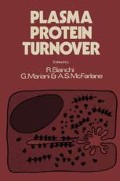Abstract
In recent years much attention has been devoted to the techniques of affinity chromatography for studying complex biological systems1. The basic principle is to immobilise one of the components of the interacting system by binding to an insoluble support, preferably through covalent bonds2,3. The biologically active support can be used to separate selectively from the reaction mixture the component with which it interacts. A successive elution yields pure components4–6. This technique consequently looks very promising both as an analytical method7 and for studying the mode of action of biological substances8,9.
Access this chapter
Tax calculation will be finalised at checkout
Purchases are for personal use only
Preview
Unable to display preview. Download preview PDF.
References
Cuatrecasas, P. and Anfinsen, C. B. Affinity chromatography. Ann. Rev. Biochem., 40 (1971), 259
Silman, I. H. and Katchalski, E. Water-insoluble derivatives of enzymes, antigens, and antibodies. Ann. Rev. Biochem., 35 (1966), 873
Cuatrecasas, P. Protein purification by affinity chromatography. J. Biol. Chem., 245 (1970), 3059
Sato, N. and Carcille, M. Separation of specific from nonspecific anti-FSH antibody by affinity chromatography on Sepharose-HCG. Endocrinology, 90 (1972), 302
Pensky, J. and Marshall, J. S. Studies on thyroxine-binding globulin (TBG). Arch. Biochem. Biophys., 135 (1969), 304
Steers, E. Jr., Cuatrecasas, P. and Pollard, H. B. The purification of β-galactosidase from Escherichia Coli by affinity chromatography. J. Biol. Chem., 246 (1971), 196
Weintraub, B. D. and Kadesky, Y. M. Fractionation of antibodies to human chorionic somatomammotropin: application to radioimmunoassay. J. Clin. Endocr., 33 (1971), 432
Rosenberry, T. L., Chang, H. W. and Chen, Y. T. Purification of acetylcholinesterase by affinity chromatography and determination of active site stoichiometry. J. Biol. Chem., 247 (1972), 1555
Olesen, H., Molin, J., Hippe, E., Rye, M., Thomsen, J., Lee, L. and Haber, E. (1972). Studies on human intrinsic factor purified by affinity chromatography. 8th International Congress on Clinical Chemistry. Copenhagen, 18–23 June, abs. in Scand. J. Clin. Lab. Invest., 29, sup. 126 (1972).
Wide, L. Radioimmunoassay employing immunosorbents. Acta Endocrin., Copenhagen, 63, suppl. 142 (1969), 207
Cuatrecasas, P. and Parikh, I. Adsorbents for affinity chromatography. Use of N-hydroxysuccinimide esters of agarose. Biochem., 11 (1972), 2291
Ludens, J. H., De Vries, J. R. and Fanestil, D. D. Criteria for affinity chromatography of steroid-binding macromolecules. J. Biol. Chem., 247 (1972), 7533
Massaglia, A., Rolleri, E., Barbieri, U. and Rosa, U. Fractionation of antibodies to testosterone. J. Clin. Endocrinol. Metab., 38 (1974), 820
Sica, V., Parikh, I., Nola, E., Puca, G. A. and Cuatrecasas, P. Affinity chromatography and the purification of oestrogen receptors. J. Biol. Chem., 248 (1973), 6543
Rosner, W. and Bradlow, H. L. Purification of corticosteroid-binding globulin from human plasma by affinity chromatography. J. Clin. Endocrinol. Metab., 33 (1971), 193
Burstein, S. H. The removal of testosterone binding globulin from plasma by affinity chromatography. Steroids., 14 (1969), 263
Ludens, J. H., De Vries, J. R. and Fanestil, D. D. Studies on affinity chromatography of aldosterone-binding macromolecules. Steroid Biochem., 3 (1972), 192
Vonderhaar, B. and Muller, G. C. Binding of oestrogen receptor to oestradiol immobilised on insoluble resins. Biochem. Biophys. Acta, 176 (1969), 626
Bolton, A. E. and Hunter, W. M. The use of antisera covalently coupled to agarose, cellulose and Sephadex in radioimmunoassay systems for proteins and haptens. Biochim. Biophys. Acta, 329 (1973), 318
Travis, J. and Pannel, R. Selective removal of albumin from plasma by affinity chromatography. Clinica Chimica Acta, 49 (1973), 49
Editor information
Editors and Affiliations
Copyright information
© 1976 The Contributors
About this chapter
Cite this chapter
Comoglio, S., Massaglia, A., Rolleri, E., Rosa, U. (1976). Preparation of biospecific supports for affinity chromatography and immunoadsorption. In: Bianchi, R., Mariani, G., McFarlane, A.S. (eds) Plasma Protein Turnover. Palgrave Macmillan, London. https://doi.org/10.1007/978-1-349-02644-9_23
Download citation
DOI: https://doi.org/10.1007/978-1-349-02644-9_23
Publisher Name: Palgrave Macmillan, London
Print ISBN: 978-1-349-02646-3
Online ISBN: 978-1-349-02644-9
eBook Packages: Biomedical and Life SciencesBiomedical and Life Sciences (R0)

